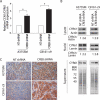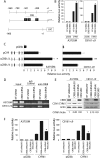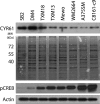Silencing cAMP-response element-binding protein (CREB) identifies CYR61 as a tumor suppressor gene in melanoma
- PMID: 19632997
- PMCID: PMC2758018
- DOI: 10.1074/jbc.M109.019836
Silencing cAMP-response element-binding protein (CREB) identifies CYR61 as a tumor suppressor gene in melanoma
Abstract
Metastatic progression of melanoma is associated with overexpression and activity of cAMP-response element-binding protein (CREB). However, the mechanism by which CREB contributes to tumor progression and metastasis remains unclear. Here, we demonstrate that stably silencing CREB expression in two human metastatic melanoma cell lines, A375SM and C8161-c9, suppresses tumor growth and experimental metastasis. Analysis of cDNA microarrays revealed that CREB silencing leads to increased expression of cysteine-rich protein 61 (CCN1/CYR61) known to mediate adhesion, chemostasis, survival, and angiogenesis. Promoter analysis and chromatin immunoprecipitation assays demonstrated that CREB acts as a negative regulator of CCN1/CYR61 transcription by directly binding to its promoter. Re-expression of CREB in CREB-silenced cells rescued the low CCN1/CYR61 expression phenotype. CCN1/CYR61 overexpression resulted in reduced tumor growth and metastasis and inhibited the activity of matrix metalloproteinase-2. Furthermore, its overexpression decreased melanoma cell motility and invasion through Matrigel, which was abrogated by silencing CCN1/CYR61 in low metastatic melanoma cells. Moreover, a significant decrease in angiogenesis as well as an increase in apoptosis was seen in tumors overexpressing CCN1/CYR61. Our results demonstrate that CREB promotes melanoma growth and metastasis by down-regulating CCN1/CYR61 expression, which acts as a suppressor of melanoma cell motility, invasion and angiogenesis.
Figures







Similar articles
-
Platelet-activating factor mediates MMP-2 expression and activation via phosphorylation of cAMP-response element-binding protein and contributes to melanoma metastasis.J Biol Chem. 2006 Feb 3;281(5):2911-22. doi: 10.1074/jbc.M508683200. Epub 2005 Nov 23. J Biol Chem. 2006. PMID: 16306050
-
Long noncoding RNA CPS1-IT1 suppresses melanoma cell metastasis through inhibiting Cyr61 via competitively binding to BRG1.J Cell Physiol. 2019 Dec;234(12):22017-22027. doi: 10.1002/jcp.28764. Epub 2019 May 20. J Cell Physiol. 2019. PMID: 31111478
-
Circ-GLI1 promotes metastasis in melanoma through interacting with p70S6K2 to activate Hedgehog/GLI1 and Wnt/β-catenin pathways and upregulate Cyr61.Cell Death Dis. 2020 Jul 30;11(7):596. doi: 10.1038/s41419-020-02799-x. Cell Death Dis. 2020. PMID: 32732916 Free PMC article.
-
Targeting the ATF-1/CREB transcription factors by single chain Fv fragment in human melanoma: potential modality for cancer therapy.Crit Rev Immunol. 2001;21(1-3):275-86. Crit Rev Immunol. 2001. PMID: 11642609 Review.
-
Biological functions and role of CCN1/Cyr61 in embryogenesis and tumorigenesis in the female reproductive system (Review).Mol Med Rep. 2018 Jan;17(1):3-10. doi: 10.3892/mmr.2017.7880. Epub 2017 Oct 26. Mol Med Rep. 2018. PMID: 29115499 Free PMC article. Review.
Cited by
-
CCN2 expression and localization in melanoma cells.J Cell Commun Signal. 2011 Aug;5(3):219-26. doi: 10.1007/s12079-011-0128-0. Epub 2011 Jun 12. J Cell Commun Signal. 2011. PMID: 21667293 Free PMC article.
-
Aurora Kinase A is a Biomarker for Bladder Cancer Detection and Contributes to its Aggressive Behavior.Sci Rep. 2017 Jan 19;7:40714. doi: 10.1038/srep40714. Sci Rep. 2017. PMID: 28102366 Free PMC article.
-
Targeting CREB in Cancer Therapy: A Key Candidate or One of Many? An Update.Cancers (Basel). 2020 Oct 28;12(11):3166. doi: 10.3390/cancers12113166. Cancers (Basel). 2020. PMID: 33126560 Free PMC article. Review.
-
Increased vascularity and spontaneous metastasis of breast cancer by hedgehog signaling mediated upregulation of cyr61.Oncogene. 2012 Jul 12;31(28):3370-80. doi: 10.1038/onc.2011.496. Epub 2011 Nov 7. Oncogene. 2012. PMID: 22056874 Free PMC article.
-
A-to-I miR-378a-3p editing can prevent melanoma progression via regulation of PARVA expression.Nat Commun. 2018 Jan 31;9(1):461. doi: 10.1038/s41467-018-02851-7. Nat Commun. 2018. PMID: 29386624 Free PMC article.
References
-
- de Gruijl F. R. (1999) Eur. J. Cancer 35, 2003–2009 - PubMed
-
- Jemal A., Siegel R., Ward E., Hao Y., Xu J., Murray T., Thun M. J. (2008) CA Cancer J. Clin. 58, 71–96 - PubMed
-
- de Braud F., Khayat D., Kroon B. B., Valdagni R., Bruzzi P., Cascinelli N. (2003) Crit. Rev. Oncol. Hematol. 47, 35–63 - PubMed
-
- Smith A. P., Weeraratna A. T., Spears J. R., Meltzer P. S., Becker D. (2004) Cancer Biol. Ther. 3, 104–109 - PubMed
-
- McDonald S. L., Edington H. D., Kirkwood J. M., Becker D. (2004) Cancer Biol. Ther. 3, 110–120 - PubMed
Publication types
MeSH terms
Substances
Grants and funding
LinkOut - more resources
Full Text Sources
Other Literature Sources
Medical
Research Materials
Miscellaneous

